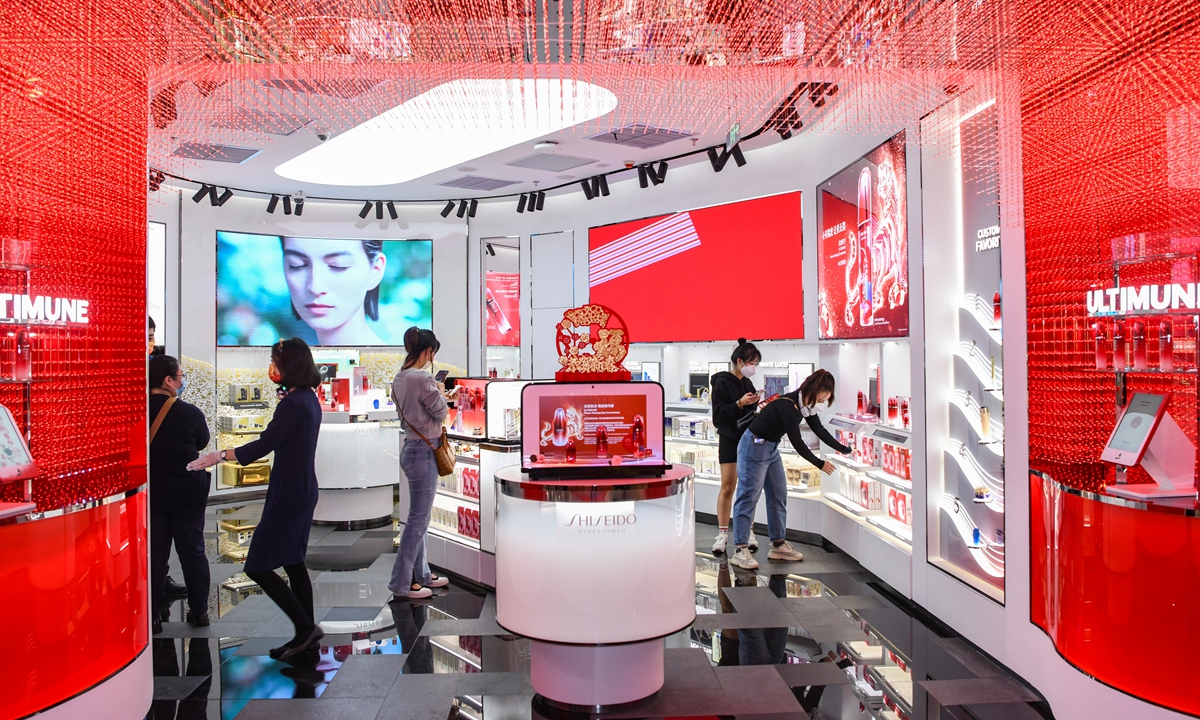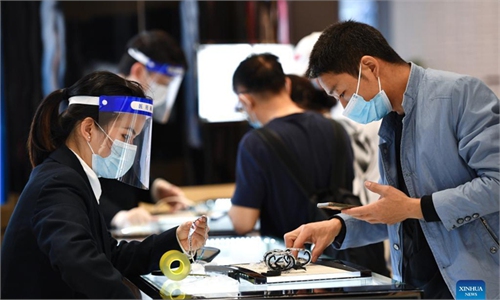Offshore duty-free shopping boom
Government support, restrained overseas travel supercharge industry growth

Consumers shop at the duty-free shop in Haikou, South China's Hainan Province on January 15, 2022 Photo: VCG
The epidemic has curbed overseas travel for two years, but the spending enthusiasm of Chinese consumers has not vanished. Duty-free sales in China have witnessed a booming growth over recent years driven by shoppers who cannot travel abroad.
The coming Chinese New Year has provided fresh impetus for the retail sector, and although some provinces have issued policies encouraging residents to reduce travel during the holidays, travel to Sanya, capital of South China's Hainan Province, also known as China's Hawaii, remains its attraction.
Data from qunar.com sent to the Global Times on Wednesday showed that Sanya is ranked as the top city choice for hotel bookings. The average nightly price of hotels in Sanya reached 1,471 yuan ($232), the highest among major Chinese cities, and family suites during the Spring Festival were sold out.
Market insiders also said that travel fever in Sanya is above that of last year, and that more tourists are translating into more duty-free sales.
Kong Lan, a resident in Shenzhen travelled with her colleagues at the end of December to Sanya, and found herself lured into a shopping spree.
She not only helped her sister in Beijing who cannot travel overseas buy several sets of SKII products for at least 4,000 yuan, she also found her colleagues were also shopping crazy, each spending over 5,000 yuan on products ranging from cosmetics to cigarettes.
Following doubling volume of the offshore duty-free sales in Hainan in 2020, local duty-free sales maintained rapid growth throughout 2021.
Offshore duty-free sales of Hainan reached 60.2 billion yuan in 2021, an increase of 84 percent year on year, according to the provincial department of commerce, according to Xinhua News Agency.
The department also reported that, the number of shoppers totaled nearly 9.7 million in 2021, with about 53.5 million items purchased, up 73 percent and 71 percent year on year, respectively.
Three more duty-free shops opened last year in Hainan, raising the total number to 10. These duty-free shops host more than 720 brands in a total, with a combined shopping area of 220,000 square meters.
From July 1, 2020, Hainan has raised its annual tax-free shopping quota from 30,000 yuan to 100,000 yuan per person. The duty-free purchase limit for cosmetics was also raised from 12 to 30 items.
The province has also rolled out a range of policies such as flexible pick-up services to provide a better experience for inter-province shoppers.
Duty-free shopping has become one of the major selling points of Hainan's tourism sector. Apart from the unmatched island scenery, it has become a new reason for tourists to book a holiday to the island.
The GDP of Hainan reached 647.52 billion yuan in 2021, surging 11.2 percent from a year earlier, according to the Hainan Provincial Bureau of Statistics.
Duty-free shopping soars
Major airports are also an important venue for duty-free business, but have been hurt badly by the epidemic.
A fiscal report released by Shanghai Airport predicted that rental income from duty-free shops in the airport in the fourth quarter of 2021 may not exceed the amount in the third quarter, which was 149 million yuan.
China released a master plan in June 2020 to build the island province into a globally influential and high-level free trade port by the middle of the century. Amid the COVID-19 pandemic, Hainan has grown into an attractive shopping destination for domestic shoppers.
A suite of concessional policies has also boosted market confidence. China Tourism Group Duty Free Corp, the world's largest travel retailer, on Friday reported revenue of 67.67 billion yuan in 2021, up 28.65 percent year-on-year, and the profit hit 9.58 billion yuan, an increase of 56.23 percent than last year.
Chen Guoqiang, general manager of the group said there is still a lot of room for business growth in the future, and the decline in gross profit margin caused by discounts and promotions last year is only a temporary phenomenon
The Ministry of Finance, together with other departments announced on January 20 that duty-free shops that have been approved and complete the bidding may extend their operating period up to a maximum of two years.
The ministry explained that the move is to alleviate the impact of the epidemic on market players and promote the healthy development of the industry.
However, the uncertain epidemic landscape has also cast a shadow over consumer spending, including major cities like Beijing, Tianjin and Shanghai that have encouraged residents to avoid travel during Chinese New Year, impacting the forecast business performance of Hainan's duty-free sector. However, over the long-term, as the epidemic is brought under control, with the right policy support in place, industry insiders are predicting a positive future, a report released by East Asia Qianhai Securities said earlier this month.
Around 21 percent of the global consumer spending on luxury goods came from the Chinese mainland in 2021 and China is expected to become the world's largest luxury market by 2025, Xinhua News Agency reported, citing data from global management consulting firm Bain & Company.
The company released its China Luxury Report 2021 recently, highlighting that the domestic sales of personal luxury goods in the Chinese mainland notched up a 36 percent year-on-year increase to nearly 471 billion yuan in 2021. The sales figure almost doubled compared to that of 2019.

